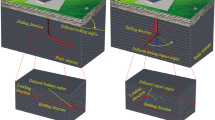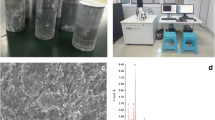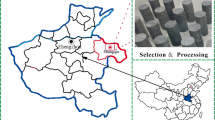Abstract
To experimentally investigate the stability of underground excavations under dry–wet cycles and different fissure angles, several rock samples with prefabricated fissure angles were prepared and subjected to the coupled influence of dry–wet cycles and axial loading until failure. Results show that the rock strength is affected by the dry–wet cycles and fissure angle, thereby yielding the strength expression. Based on the characteristics of elastic and dissipation energy ratios, the energy evolution process of the rock samples is divided into the initial dissipation energy stage, stable dissipation energy–growth stage, dissipation energy–acceleration stage, and dissipation energy–surge stage. The sensitivity of the peak total energy and elastic strain energy of the rock samples to the fissure angle decreases as the number of dry–wet cycles increases. The difficulty degree of rock deformation and failure caused by energy exhibits a difficult–easy–difficult evolution characteristic as the fissure angle increases, while the evolution characteristic gradually weakens with an increase in the number of dry–wet cycles. The failure modes of the rock samples are controlled by the fissure angles and the dry–wet cycles. Tensile failure requires more energy than shear failure. As the number of dry–wet cycles increases, the elastic strain energy decreases, rock failure intensity weakens, and surface shedding reduces. The findings of this study provide a significant understanding of the instability and failure of underground rock engineering.












Similar content being viewed by others
Availability of data and materials
All data and materials support our published claims and comply with field standards.
References
Boldini D, Graziani A (2012) Remarks on axisymmetric modelling of deep tunnels in argillaceous formations-II: fissured argillites. Tunn Undergr Sp Tech 28(3):80–89
Cao P, Liu T, Pu C, Lin H (2015) Crack propagation and coalescence of brittle rock-like specimens with pre-existing cracks in compression. Eng Geol 187:113–121
Chen LH, Chen WC, Chen YC, Li AJ (2014) Investigation of hydraulic fracture propagation using a post peak control system coupled with acoustic emission. Rock Mech Rock Eng 48:1233–1248
Cheng H, Zhou X, Zhu J, Qian Q (2016) The effects of crack openings on crack initiation, propagation and coalescence behavior in rock-like materials under uniaxial compression. Rock Mech Rock Eng 49:3481–3494
Chiu YC, Lee CH, Wang TT (2017) Lining crack evolution of an operational tunnel influenced by slope instability. Tunn Undergr Sp Tech 65:167–178
Deng HF, Zhou ML, Li JL, Sun XS, Huang YL (2016a) Creep degradation mechanism by water-rock interaction in the red-layer soft rock. Arab J Geosci 9(12). https://doi.org/10.1007/s12517-016-2604-6
Deng Y, Chen M, Jin Y, Zou DW (2016b) Theoretical analysis and experimental research on the energy dissipation of rock crushing based on fractal theory. J Nat Gas Sci Eng 33:231–239
Gong FQ, Luo S, Yan JY (2018) Energy storage and dissipation evolution process and characteristics of marble in three tension-type failure tests. Rock Mech Rock Eng 51(11):3613–3624
Hale PA, Shakoor A (2003) A laboratory investigation of the effects of cyclic heating and cooling, wetting and drying, and freezing and thawing on the compressive strength of selected sandstones. Environ Eng Geosci 9(2):117–130
Khanlari G, Abdilor Y (2015) Influence of wet-dry, freeze-thaw, and heat-cool cycles on the physical and mechanical properties of Upper Red sandstones in central Iran. Bull Eng Geol Environ 74(4):1287–1300
Liu XR, Jin MH, Li DL, Zhang L (2018) Strength deterioration of a Shaly sandstone under dry-wet cycles: a case study from the Three Gorges Reservoir in China. Bull Eng Geol Environ 77(4):1607–1621
Ma CQ, Li HZ, Niu Y (2018) Experimental study on damage failure mechanical characteristics and crack evolution of water-bearing surrounding rock. Environ Earth Sci 77(23). https://doi.org/10.1007/s12665-017-7209-1
Ma Q, Li Z, Xiao HL, Hu Z, Pung L (2021) Mechanical properties of clay reinforced with Bermuda grass root under drying-wetting cycles. Environ Earth Sci 80(1). https://doi.org/10.1007/s12665-020-09278-8
Papathanassiou G, Valkaniotis S, Ganas A, Grendas N, Kollia E (2017) The November 17th, 2015 Lefkada (Greece) strike-slip earthquake: field mapping of generated failures and assessment of macroseismic intensity ESI-07. Eng Geol 220:13–30
Sih GC (1974) Strain-energy-density factor applied to mixed mode crack problems. Int J Fract 10(3):305–321
Srodon J, Drits VA, Mccarty DK, Hsieh JC, Eberl DD (2001) Quantitative X-ray diffraction analysis of clay-bearing rocks from random preparations. Clay Clay Miner 49(6):514–528. https://doi.org/10.1346/CCMN.2001.0490604
Sweetenham MG, Maxwell RM, Santi PM (2013) Assessing the timing and magnitude of precipitation-induced seepage into tunnels bored through fractured rock. Tunn Undergr Sp Tech 65:62–75
Wang XG, Lian BQ, Wang JD, Feng WK, Gu TF (2020) Creep damage properties of sandstone under dry-wet cycles. J Mt Sci 17:3112–3122
Xie HP, Ju Y, Li LY (2005) Criteria for strength and structural failure of rocks based on energy dissipation and energy release principles. Chinese Journal of Rock Mechanics and Engineering 24(17): 3003–3010
Xu J, Li YF, Ren C, Wei L (2020) Damage of saline intact loess after dry-wet and its interpretation based on SEM and NMR. Soils Found 60(4):911–928
Yang TH, Xu T, Rui RQ, Tang CA (2004) The deformation mechanism of a layered creeping coal mine slope and the associated stability assessments. Int J Rock Mech Min 41(41):827–832
Yang K, Liu WJ, Dou LT, Chi XL, Wei Z, Fu Q (2020) Experimental investigation into interface effect and progressive instability of coal-rock combined specimen. Journal of China Coal Society 45(5):1691–1700
Yu LQ, Yao QL, Li XH, Wang WN, Han H, Zhang MT (2020) Experimental study of failure characteristics and fissure propagation in hydrous siltstone. Arab J Geosci 13:527. https://doi.org/10.1007/s12517-020-05522-4
Zhou HW, Wang ZH, Wang CS, Liu JF (2018) On acoustic emission and post-peak energy evolution in Beishan granite under cyclic loading. Rock Mech Rock Eng 52(1):283–288. https://doi.org/10.1007/s00603-018-1614-y
Zhou ZL, Cai X, Cao WZ, Li XB, Xiong X (2016) Influence of water content on mechanical properties of rock in both saturation and drying processes. Rock Mech Rock Eng 49(8):3009–3025
Acknowledgements
We thank Liwen Bianji (Edanz) (www.liwenbianji.cn) for editing the English text of a draft of this manuscript.
Funding
The support provided by the National Natural Science Foundation of China (Grant No. 51674041) is gratefully acknowledged.
Author information
Authors and Affiliations
Contributions
All the authors contributed to the study’s conception and design. Material preparation, data collection, and analysis were performed by Xinxi Liu, Yu Li, and Weiwei Wang. The first draft of the manuscript was written by Yu Li, and all the authors commented on previous versions of the manuscript. All the authors read and approved the final manuscript.
Corresponding author
Ethics declarations
Consent to participate
Informed consent was obtained from all individual participants included in the study.
Consent for publication
The participants have consented to the submission of the manuscript to the journal.
Conflict of interest
The authors declare no competing interests.
Rights and permissions
About this article
Cite this article
Liu, X., Li, Y. & Wang, W. Study on mechanical properties and energy characteristics of carbonaceous shale with different fissure angles under dry–wet cycles. Bull Eng Geol Environ 81, 319 (2022). https://doi.org/10.1007/s10064-022-02823-8
Received:
Accepted:
Published:
DOI: https://doi.org/10.1007/s10064-022-02823-8




